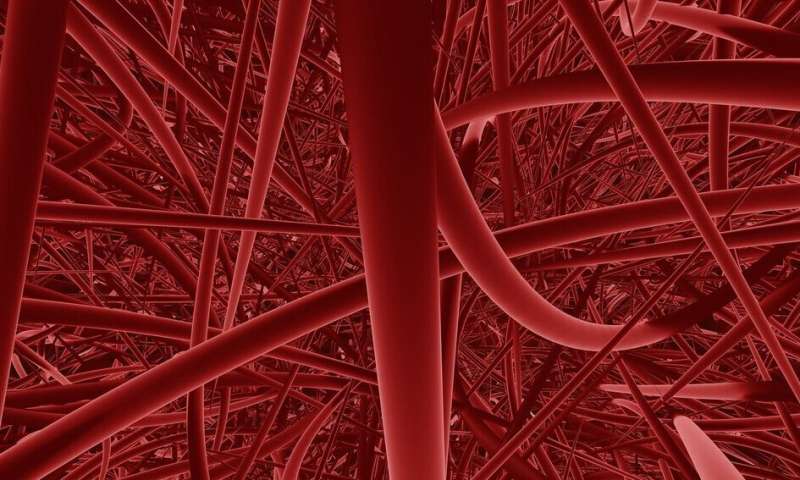Networking nano-biosensors for wireless communication in the blood

Biological computing machines, such as micro and nano-implants that can collect important information inside the human body, are transforming medicine. Yet, networking them for communication has proven challenging. Now, a global team, including EPFL researchers, has developed a protocol that enables a molecular network with multiple transmitters.
First, there was the Internet of Things (IoT) and now, at the interface of computer science and biology, the Internet of Bio-Nano Things (IoBNT) promises to revolutionize medicine and health care. The IoBNT refers to biosensors that collect and process data, nano-scale Labs-on-a-Chip that run medical tests inside the body, the use of bacteria to design biological nano-machines that can detect pathogens, and nano-robots that swim through the bloodstream to perform targeted drug delivery and treatment.
“Overall, this is a very, very exciting research field,” explained Assistant Professor Haitham Al Hassanieh, head of the Laboratory of Sensing and Networking Systems in EPFL’s School of Computer and Communication Sciences (IC). “With advances in bio-engineering, synthetic biology, and nanotechnology, the idea is that nano-biosensors will revolutionize medicine because they can reach places and do things that current devices or larger implants can’t,” he continued.
Yet no matter how exciting this cutting-edge research field is, there remains a huge, fundamental challenge—when you have a nano-robot in someone’s body, how will you communicate with it? Traditional techniques, like wireless radios, work well for large implants such as pacemakers or defibrillators but can’t be scaled to micro and nano-dimensions, and wireless signals don’t penetrate through body fluids.
Enter what’s being called biomolecular communication, inspired by the body itself. It doesn’t utilize electromagnetic waves but biological molecules both as carriers and as information, mimicking the existing communication mechanisms in biology. In its simplest form it encodes “1” and “0” bits by releasing or not releasing molecular particles into the bloodstream—similar to ON-OFF-Keying in wireless networks.
“Biomolecular communication has emerged as the most suitable paradigm for networking nano-implants. It’s an incredible idea that we can send data by encoding it into molecules which then go through the bloodstream and we can communicate with them, guiding them on where to go and when to release their treatments, just like hormones,” Al Hassanieh said.
Recently, Al Hassanieh and his team, in collaboration with researchers in the United States presented their paper, “Towards Practical and Scalable Molecular Networks,” at ACM SIGCOMM 2023, an annual conference on Data Communication, in which they outlined their MoMA (Molecular Multiple Access) protocol that enables a molecular network with multiple transmitters.
“Most existing research is very theoretical and doesn’t work because the theories haven’t considered biology,” explained Al Hassanieh. “For example, every time the heart pumps there’s a jitter and the body changes its internal communication channel. Most existing theory assumes that the channel that you send the molecules over is very stable and doesn’t change. It actually changes very fast.”
With MoMA, the team introduced packet detection, channel estimation, and encoding/decoding schemes that leverage the unique properties of molecular networks to address existing challenges. They evaluated the protocol on a synthetic experimental testbed—emulated blood vessels with tubes and pumps—demonstrating that it can scale up to four transmitters while significantly outperforming state-of-the-art technology.
The researchers acknowledge that their current synthetic testbed may not capture all the challenges associated with designing protocols for molecular networks and that in-vivo testing of micro-implants and micro-fluids in wet-labs is needed to achieve practical and deployable molecular networks. However, they believe they have taken the first steps towards this vision and that their insights for designing molecular networks will hold, as the underlying diffusion and fluid dynamics models in their testbed are fundamental to molecular communication
“I am very excited about this area because it’s a new form of communication. We are a systems group, we like building things and getting them working. It’s taken time to develop the expertise we have in biomolecular communication but now we are at the stage where we are finding collaborators and can get things moving. People think this is science fiction but it’s fast moving to science fact,” Al Hassanieh concluded.
More information:
Jiaming Wang et al, Towards Practical and Scalable Molecular Networks, Proceedings of the ACM SIGCOMM 2023 Conference (2023). DOI: 10.1145/3603269.3604881
Provided by
Ecole Polytechnique Federale de Lausanne
Citation:
Networking nano-biosensors for wireless communication in the blood (2023, November 22)
retrieved 22 November 2023
from https://phys.org/news/2023-11-networking-nano-biosensors-wireless-communication-blood.html
This document is subject to copyright. Apart from any fair dealing for the purpose of private study or research, no
part may be reproduced without the written permission. The content is provided for information purposes only.



